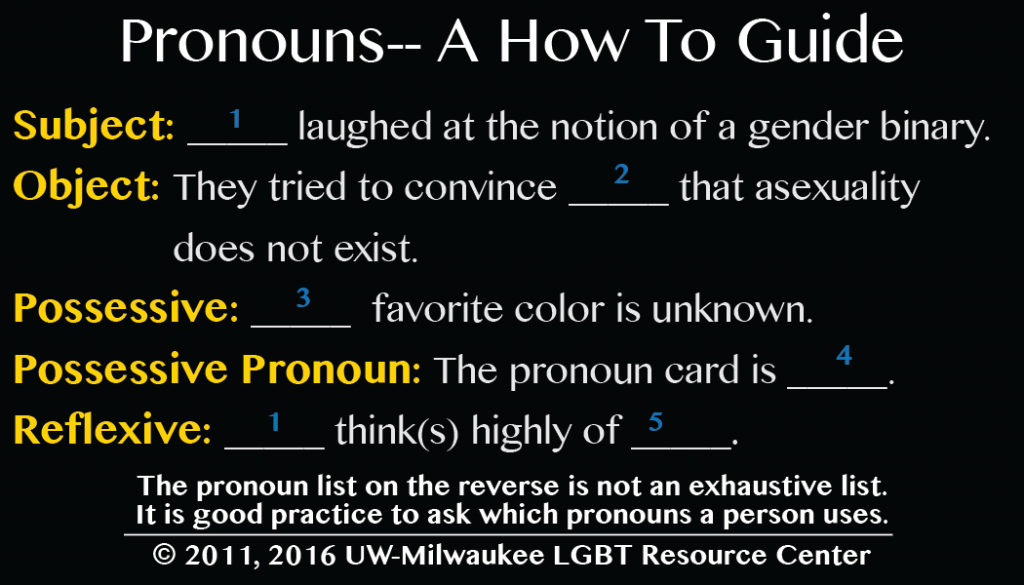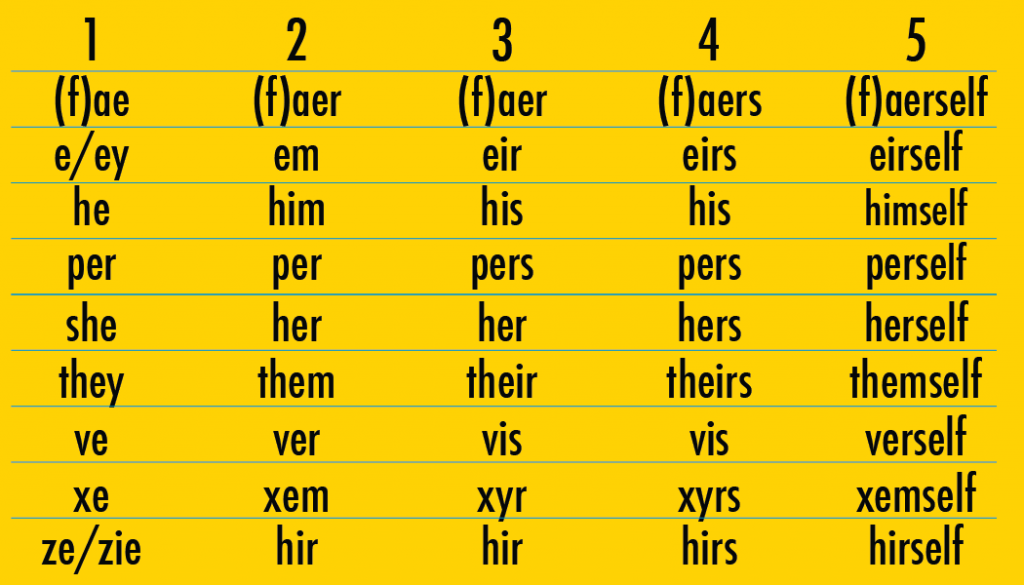Get-go, let’southward start off with the most oftentimes asked questions about Personal Gender Pronouns (PGPs).
Frequently Asked Questions
It’due south okay! Everyone slips up from time to fourth dimension. The best matter to do if yous use the wrong pronoun for someone is to say something correct away, like “Sorry, I meant (insert pronoun)”.
If you realize your mistake after the fact, apologize in private and move on.
A lot of the time it tin be tempting to keep and on about how bad you feel that you lot messed up or how difficult it is for you to get it correct. Please don’t! It is inappropriate and makes the person who was misgendered feel bad-mannered and responsible for comforting you, which is absolutely not their job.
Taking an active role in your classes, y’all may hear i of your students using the wrong pronoun for someone. In near cases, it is appropriate to gently correct them without further embarrassing the private who has been misgendered. This means saying something like “Alex uses the pronoun she,” and so moving on. If other students or faculty are consistently using the wrong pronouns for someone, practice non ignore information technology! It is important to let your student know that y’all are their ally.
It may be appropriate to arroyo them and say something like “I noticed that you were getting referred to with the incorrect pronoun earlier, and I know that that tin can be really hurtful. Would yous exist okay with me taking them bated and reminding them nearly your pronouns?” Follow upwards if necessary, but take your cues from the condolement level of your student. Your actions will be greatly appreciated.
Endeavour request: “What pronouns practice yous apply?” or “Can yous remind me what pronouns you use?” It can feel bad-mannered at starting time, but it is non one-half as awkward as making a hurtful supposition.
If you are asking equally role of an introduction exercise and yous want to quickly explain what gender pronouns are, you can attempt something like this: “Tell the states your name, where you come from, and your pronouns. That ways the pronouns that you utilise in reference to yourself. For example, I’g Xena, I’grand from Amazon Isle, and I like to exist referred to with she, her, and hers pronouns. So you could say, ‘she went to her machine’ if yous were talking about me.”
It is important to call back that by asking everyone you lot encounter which pronouns they use, you lot tin assistance create a more normalized and safe mode for others to share their pronouns, which they may not have been able to do before.
Still, some closeted people may not be set up to publicly share their pronouns, so if someone does non supply them in front of a group, try request in a more private setting. Asking someone “can I employ these pronouns for you in forepart of other people?” is a good way of making sure you practice not accidently out or misrepresent someone.
Y’all can’t always know what someone’s pronouns are past looking at them. Asking and correctly using someone’due south pronouns is one of the nigh basic ways to show your respect for their gender identity.
When someone is referred to with the wrong pronoun, information technology tin can make them experience disrespected, invalidated, dismissed, alienated, or dysphoric ( often all of the above). All major professional American psychological and psychiatric associations recognize that inclusive language usage for LGBTQ+ youth and adults drastically decreases experiences of depression, social anxiety, suicidal ideation, and other negative mental health factors.
It is a privilege to non have to worry well-nigh which pronoun someone is going to use for you based on how they perceive your gender. If you take this privilege, yet fail to respect someone else’s gender identity, it is non just disrespectful and hurtful, but besides oppressive.
She/her/hers and he/him/his are a few unremarkably used pronouns. Some people call these “feminine” and “masculine” pronouns, but many people avert these labels because not anybody who uses
he
feels “masculine.”
There are also lots of other pronouns in utilise, some of them more gender neutral. Here are a few y’all might hear:
- They/them/theirs (Shea ate their food because they were hungry.) This is a pretty common gender-neutral pronoun and it tin be used in the atypical. In fact, “they” was voted as the Word of the Year in 2015.
- Ze/hir/hir (Tyler ate hir nutrient considering ze was hungry.) Ze is pronounced similar “zee” tin can also be spelled zie or xe, and replaces she/he/they. Hir is pronounced like “hither” and replaces her/hers/him/his/they/theirs.
- Just my proper name please! (Ash ate Ash’s food because Ash was hungry) Some people prefer not to use pronouns at all, using their name as a pronoun instead.
Do not refer to a person as “it” or “he-she”. These are offensive slurs used against trans and gender not-conforming individuals.
Purposefully misgendering (using the incorrect pronouns or ignoring the pronouns in utilize) is besides offensive and disrespectful to trans and gender non-confirming individuals.
A pronoun is a word that refers to either the people talking (“I” or “you”) or someone or something that is being talked about (similar “she”, “it”, “them”, and “this”). Gender pronouns (he/she/they/ze etc.) specifically refer to the person you are referring to.
Pronouns are part of someone’s gender expression, and people can have multiple sets of pronouns for themselves (such as using motion he/him/his and they/them/theirs). Pronouns are not “preferred” but instead are required for respectful communication. Non only transgender or nonbinary communities use pronouns, equally it is something we all use and have since we were fiddling.
Pronouns – A How To Guide

 Note: the top line is meant to indicate ii separate – just similarly spelled – sets of pronouns. They are ae/aer/aers and fae/faer/faers.
Note: the top line is meant to indicate ii separate – just similarly spelled – sets of pronouns. They are ae/aer/aers and fae/faer/faers.
Pronouns Exercise App (Minus18)
Gender Neutral / Gender Inclusive Pronouns
A gender neutral or gender inclusive pronoun is a pronoun which does non acquaintance a gender with the individual who is existence discussed.
Some languages, such every bit English language, exercise not have a gender neutral or tertiary gender pronoun available, and this has been criticized, since in many instances, writers, speakers, etc. use “he/his” when referring to a generic individual in the 3rd person. Besides, the dichotomy of “he and she” in English language does not get out room for other gender identities, which is a source of frustration to the transgender and gender queer communities.
People who are limited by languages which practise non include gender neutral pronouns have attempted to create them, in the interest of greater equality.
| SHE | HER | HER | HERS | HERSELF |
| HE | HIM | HIS | HIS | HIMSELF |
| zie | zim | zir | zis | zieself |
| sie | sie | hir | hirs | hirself |
| ey | em | eir | eirs | eirself |
| ve | ver | vis | vers | verself |
| tey | ter | tem | ters | terself |
| e | em | eir | eirs | emself |
History of Gender Inclusive Pronouns
Native English Pronouns
“Ou, a”: Native English Gender-Neutral Pronouns. According to Dennis Businesswoman’due south Grammer and Gender:
In 1789, William H. Marshall records the existence of a dialectal English epicene pronoun, atypical ou : "'Ou will' expresses eitherhe will,she will, orit will." Marshall traces ou to Center English language epicene a, used by the fourteenth-century English writer John of Trevisa, and both the OED and Wright's English Dialect Dictionary ostend the use of a forhe, she, it, they, and evenI.
The dialectal epicene pronoun a is a reduced form of the Old and Eye English masculine and feminine pronounshe andheo. By the twelfth and thirteenth centuries, the masculine and feminine pronouns had adult to a point where, according to the OED, they were "virtually or wholly indistinguishable in pronunciation." The modernistic feminine pronounshe, which get-go appears in the mid twelfth century, seems to have been drafted at least partly to reduce the increasing ambiguity of the pronoun organisation....
He goes on to describe how relics of these sex-neutral terms survive in some British dialects of Mod English, and sometimes a pronoun of one gender might be applied to a person or animal of the reverse gender.
Language Authorities
“One”
In 1770, Robert Baker suggested use of “one, ones” instead of “one, his”, since there was no equivalent “i, hers”. Others shared this sentiment in 1868, 1884, 1979, and even now. Others throughout this period disagreed, finding it too pedantic.
“His or Her” vs. Singular “They”
Effectually 1795, the language regime Lindley Murray, Joseph Priestly, and Hugh Blair, amongst others, campaigned against pronoun irregularities in pronoun use, such every bit lack of agreement in gender and number. Without coining words, this can only exist washed in the tertiary person singular by utilise of compound terms like “his or her”. Grammarians in 1879, 1922, 1931, 1957, and the 1970s have accepted “they” every bit a atypical term that could be used in identify of “he” or “he or she”, though sometimes limiting it to informal constructions. Others in 1795, 1825, 1863, 1898, 1926, and 1982 argued against it for various reasons. And whatsoever the grammarians might contend, people accept been using the singular “they” for about the last 600 years, though (as mentioned earlier) it can only be applied in certain cases. If new gender-neutral pronouns are not adopted, i’m certain that singular “they” will still exist a betoken of contention for centuries to come up. For further information on the employ of atypical “their” throughout the centuries, run across the large body of information that Henry Churchyard has compiled on the subject.
 This work is licensed under a Creative Commons Attribution-NonCommercial iv.0 International License.
This work is licensed under a Creative Commons Attribution-NonCommercial iv.0 International License.
Source: https://uwm.edu/lgbtrc/support/gender-pronouns/







